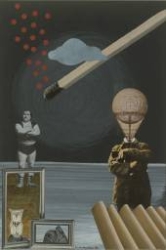Although he eventually outgrew the city, Maddox was inspired by urban Birmingham—with its libraries, theatres, and art galleries—after a youth spent in the countryside. In his (impeccably illustrated) biography of Maddox, The Scandalous Eye, Silvano Levy quotes generously from conversations and correspondence with the artist. These insights from Maddox provide a context for Henry Reed's social life in Birmingham before the war:
During that time, I began to explore the possibilities I discovered in collage which questioned the innocence of all images and the allusiveness of reality. Evenings were spent with in talk with Robert and John Melville, the poet Henry Reed, and Dorothy Baker. On Sundays, we would go to the Film Society and saw for the first time the works of Eisenstein, Cocteau, Pudovkin, Fritz Lang and others. Afterwards, we would talk either about the film or more imaginatively. (p. 45)
Reed, of course, was raised in Erdington, and from 1932-1936 he was studying at the University of Birmingham. Robert Melville would later become the art critic for the New Statesman. His brother, John Melville, was an artist also interested in Surrealism, who had occasion to paint a rather more traditional portrait of Reed (popup window). Along with Emmy Bridgwater, William Gear, and Stuart Gilbert, this circle of artists became the Birmingham Group. But Maddox's group of friends and followers was not not limited to painters:
The entourage included George Painter, Harry Browne and Philip Troutman, who were literary scholars; Cornelius Russell, an art historian at the university; his wife Jane; Dorothie Hewlett; Edward Lowbry [sic], a microbiologist and poet; Roy Knight, a modern languages academic who had unsuccessfully tried to teach Maddox some French; Dorothy Baker, a writer; and the poet Henry Reed, who, whenever the opportunity arose, would introduce his 'heterosexual friend Conroy Maddox'. (p. 98)
Reed's openness (and humor) about his sexuality never ceases to surprise me.
This litany of Birmingham's intellectual A-list will keep me busy for weeks, hunting the library stacks for biographies and collected letters, sliding my digitus secundus down the "R" pages of indexes, looking for references to Reed (is that why it's called the "index" finger?).
George Painter, the Proust biographer, had attended secondary school with Reed (see previous post). My Granger's Index lists five poems of Edward Lowbury which appear in various anthologies. His poem on the Hiroshima bombing, "August 10th, 1945—The Day After," appears on the Salamander Oasis Trust website. Lowbury's Collected Poems was published in 1993 (Contemporary Review 263, no. 1535 (December 1993): 329-330).
The two mentions of Dorothy Baker are especially intriguing,
A severely limited preview of Levy's The Scandalous Eye: The Surrealism of Conroy Maddox is available from Google Books (the copyrighted images appear to be restricted). I have a library copy here beside me, and it's a beautiful, glossy-paged book. I'm astute enough (but only just) to detect the influence of Picasso, Magritte, and Dali in Maddox's work, but I fear I have been forever spoiled for his googly-eyed collages by the Spongmonkeys (Flash, audio, weird).








